In This Article
- Main Highlights
- Comparing Carbon Footprints
- Water and Energy Use
- Land and Waste Impact
- Production and Shipping
- Consumer Perceptions
- Ethical and Social Factors
- Explore Sustainable Luxury with After Diamonds
- Frequently Asked Questions
- How Do Lab-Grown Diamonds Compare in Cost to Natural Diamonds?
- Can Lab-Grown Diamonds Be Customised for Unique Jewellery Designs?
- What Technological Advancements Are Driving Lab-Grown Diamond Production?
- Are There Aesthetic Differences Between Lab-Grown and Natural Diamonds?
- How Long Does It Take to Produce a Lab-Grown Diamond?
Here at After Diamonds, we strongly believe in the brilliance and beauty of lab-grown diamonds, a sustainable choice, that reflects both elegance and environmental responsibility.
Choosing lab-grown diamonds makes a sustainable impact by greatly reducing carbon emissions—nearly 60% less than mined diamonds. They use around 70 litres of water per carat, much lower than the 480 litres required for mining, and draw about 250-750 kWh per carat, positioned against the daily usage of an average home. They require far less earth displacement, avoiding major habitat destruction and minimising mineral waste to just 1 pound per carat compared to 6,000 pounds from mining. Moreover, they guarantee conflict-free sourcing and promote ethical labour practices. Investigate further to uncover how this choice benefits both you and the planet.
Main Highlights
- Lab-grown diamonds reduce carbon emissions by up to 60% compared to mined diamonds, significantly lowering their environmental footprint.
- They consume seven times less water per carat than mined diamonds, conserving vital water resources.
- Lab-grown diamond production entails minimal earth displacement, preserving natural landscapes and habitats.
- The controlled laboratory environment prevents pollutants from affecting ecosystems, promoting cleaner water bodies and environmental conservation.
- Their production generates only one pound of mineral waste per carat, supporting sustainable waste management practices.
Chloe Lab Diamond Halo Oval Engagement Ring 0.85ct D/VVS in 18k White Gold
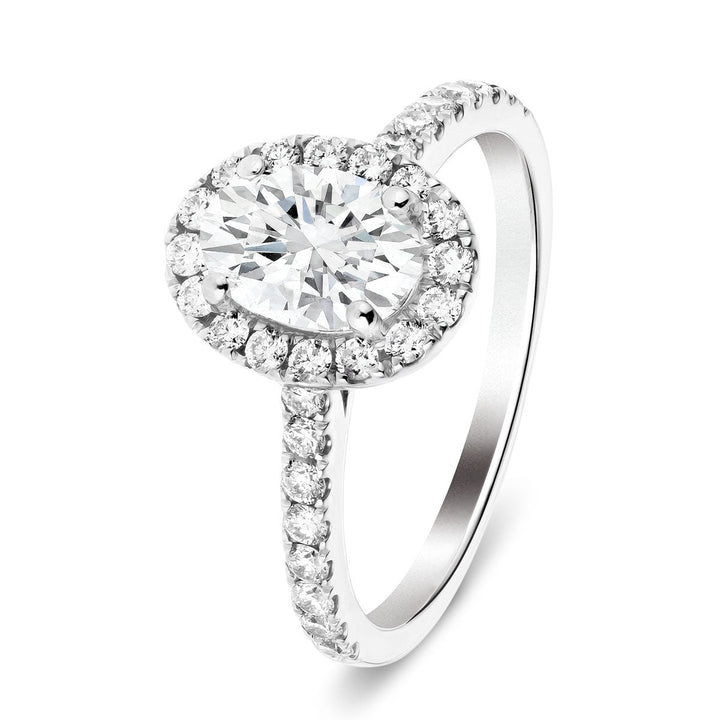
£1,060.00
£2,021.00
Cherish your love forever with the beauty of the Chloe Lab Diamond Halo Oval Engagement Ring. This stunning ring features a captivating 0.85-carat total weight of diamonds, including an oval cut D/VVS certified diamond at the centre of a halo… read more
Comparing Carbon Footprints
When comparing the carbon footprints of lab-grown diamonds and mined diamonds, you'll find a considerable difference. Lab-grown diamonds can reduce carbon emissions by up to 60% compared to their mined counterparts. This difference stems from the more efficient and controlled production process of lab-grown diamonds, which results in only about 0.028 grams of carbon emissions per carat.
Lab-grown diamonds utilise renewable energy sources such as wind and solar, which significantly contributes to their lower carbon emissions. In contrast, mined diamonds produce around 0.127 grams per carat, highlighting a stark contrast in sustainability metrics.
The environmental impact of these diamonds is further emphasised by extensive life cycle assessments. These assessments indicate that lab-grown diamonds generally have a lower total environmental footprint. The predictability and transparency of their carbon footprint add to their appeal for consumers who value sustainability.
However, it's essential to keep in mind that the carbon emissions of lab-grown diamonds can vary greatly depending on the energy sources used during production.
In a world where the demand for eco-friendly choices is growing, lab-grown diamonds offer an option that aligns with these values. By understanding the sustainability metrics and carbon emissions involved, you can make informed decisions that reflect your commitment to the environment and personal freedom.
Water and Energy Use
When comparing water and energy use between mined and lab-grown diamonds, you'll find significant differences in consumption and sources. Lab-grown diamonds use considerably less water, around 70 litres per carat, compared to the 480 litres required for mined diamonds, making them a more water-efficient choice. Additionally, lab-grown diamonds have a reduced impact on the environment due to their production methods. Despite these advantages, lab-grown diamonds are produced in controlled environments that do not interfere with wildlife or ecosystems, further emphasising their environmental benefits. However, they consume roughly 250 kWh of energy per carat, often relying on non-renewable energy sources like coal, which can increase their environmental footprint, especially in regions heavily dependent on fossil fuels.
Lab Diamond Pave Heart Earrings 0.30ct D/VVS in 925 Silver
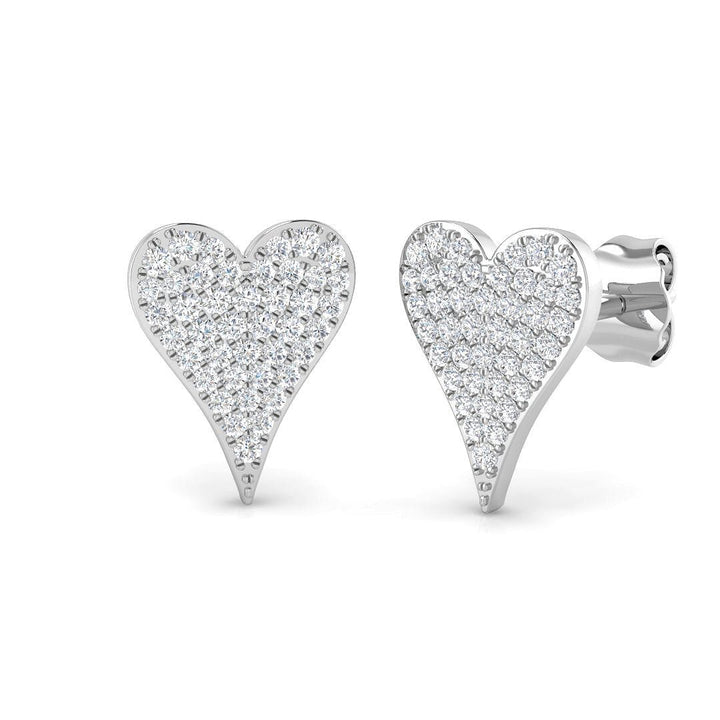
£290.00
£555.00
The Lab Diamond Pave Heart Earrings exude romance and elegance, meticulously crafted with 0.30ct of D/VVS quality lab diamonds. Each stone is expertly set in a pave arrangement, enhancing the brilliance and creating a stunning sparkle. These earrings are beautifully… read more
Water Consumption Comparison
Comparing water consumption between mined and lab-grown diamonds reveals considerable environmental differences. You'll find that the water usage for lab-grown diamonds is far lower, consuming just 18 gallons per carat compared to the hefty 126 gallons needed for mined diamonds. This massive reduction in water use is a result of effective conservation strategies employed in the controlled environments of laboratories. Moreover, the energy consumption involved in producing lab-grown diamonds is also significantly less than that of mined diamonds, further highlighting their environmental benefits. Notably, the majority of the electricity used in lab-grown diamond production is sourced from renewable resources, underscoring their commitment to sustainability.
Unlike traditional mining, lab-grown diamonds do not discharge pollutants into water bodies, meaning they have a notably lower ecological footprint.
- Lab-grown diamonds use 7 times less water than their mined counterparts.
- Reduced water usage considerably aids in natural resource conservation.
- Laboratory processes prevent contamination, ensuring cleaner ecosystems.
- Sustainable practices in labs minimise ecological risks from water use.
- Recycling and waste disposal in labs reduce environmental impacts.
With mining, the environmental damage is evident. Extracting a single diamond can require shifting nearly 1,750 tons of earth, leading to water contamination through slurry creation.
In contrast, lab-grown diamonds prevent habitat disruption and maintain water quality. This sustainable approach not only conserves wildlife habitats but also supports the preservation of riverbeds and marine life, making lab-grown diamonds a truly eco-friendly choice.
Layla Lab Diamond Halo Princess Engagement Ring 2.20ct G/VS in 18k Yellow Gold
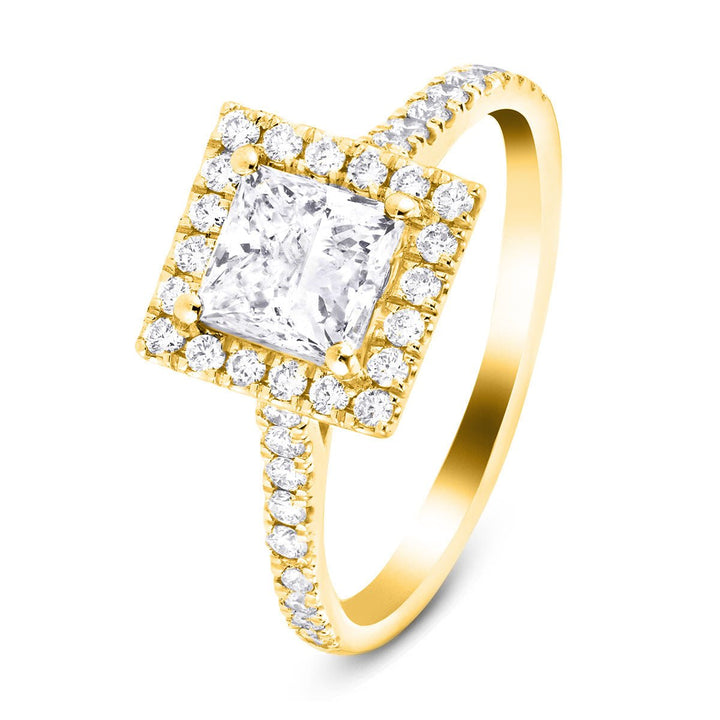
£1,870.00
£3,566.00
This Layla Lab Diamond Halo Princess Engagement Ring is a beautiful example of sophistication and elegance, designed and handcrafted in the UK with care and attention to detail. Featuring 2.20ct of diamonds, the ring has a 1.50 carat princess-cut diamond… read more
Energy Source Considerations
Understanding the energy source considerations for lab-grown diamonds is vital to grasp their environmental impact. Producing a single carat of lab-grown diamond requires between 250 and 750 kilowatt hours (kWh) of electricity, a significant amount when you consider the average UK household uses about 10 kWh per day. However, many producers are increasingly turning to renewable energy sources to improve energy efficiency and reduce their carbon footprints.
This shift is important, particularly in regions like China and India, where over 60% of lab diamonds are produced using coal-fired power, contributing to high greenhouse gas emissions. Notably, the energy consumption in lab diamond production is being actively reduced through the use of renewable energy, minimising the overall environmental impact. Lab-grown diamonds help reduce the negative environmental effects associated with traditional diamond mining, making them a sustainable choice for conscientious consumers.
Here's a comparative look at energy considerations
| Aspect | Lab-Grown Diamonds | Natural Diamonds |
| Electricity Usage (per carat) | 250-750 kWh | Varies |
| Primary Energy Source | Often fossil fuels | Increasingly renewables |
| Greenhouse Gas Emissions | 511 kg per carat | Depends on lifecycle |
Transitioning to renewable energy not only improves energy efficiency but also aligns with sustainability goals.
While lab-grown diamonds currently have a higher energy footprint than mined ones, innovations and efficiency improvements promise a more sustainable future. Embracing these changes reflects a desire for environmentally responsible choices.
Land and Waste Impact
Lab-grown diamonds dramatically reduce the environmental impact on land and waste compared to traditional diamond mining. They offer a sustainable alternative, ensuring land rehabilitation and biodiversity preservation. Unlike mined diamonds, which disrupt nearly 100 square feet of land per carat, lab-grown diamonds only affect 0.07 square feet. This minimal impact means ecosystems remain intact, and habitats aren't irreversibly damaged.
In mining, land erosion is a persistent issue, yet lab-grown diamonds eliminate this risk, preserving the natural landscape. Furthermore, lab-grown diamonds are more sustainable as they consume less water and energy and emit significantly less CO2.
When it comes to waste, lab-grown diamonds shine even brighter. Producing just 1 pound of mineral waste per carat, they starkly contrast with the 6,000 pounds generated by mined diamonds. This drastic reduction helps maintain cleaner environments and prevents water pollution from hazardous chemicals typically used in mining. Moreover, lab-grown diamond facilities prioritise recycling, ensuring waste is managed responsibly. The demand for sustainable options is driven by younger generations, who prioritise eco-friendly products and influence the market towards lab-grown diamonds.
Consider these key points:
- Land rehabilitation is more feasible with lab production.
- Biodiversity preservation is better supported through reduced habitat disruption.
- Minimal land disruption per carat compared to traditional methods.
- Significantly lower waste generation than mining operations.
- Elimination of water pollution risks from mining chemicals.
These factors highlight the eco-friendly nature of lab-grown diamonds.
Lab Diamond Solitaire Bezel Necklace Pendant 0.70ct G/VS in 9k White Gold
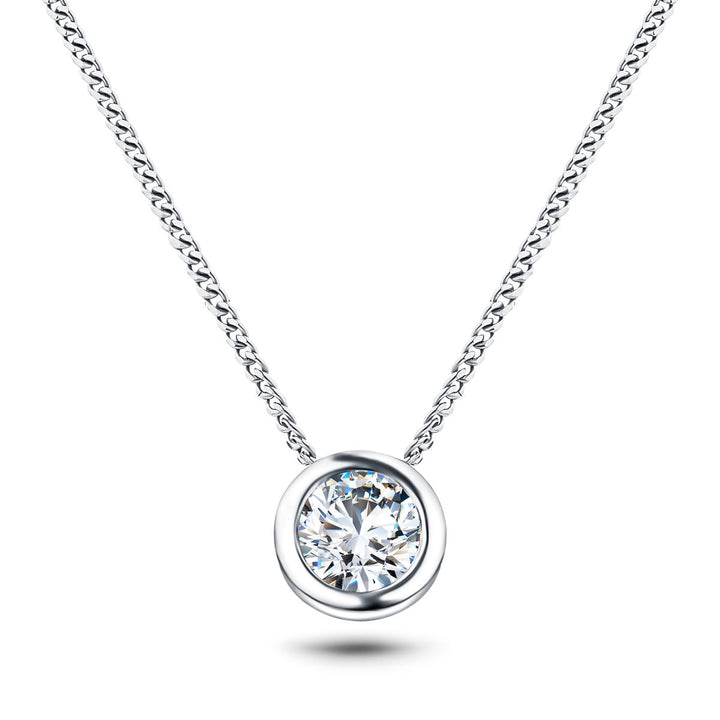
£565.00
£1,076.00
Elevate your style with this stunning Lab Diamond Solitaire Bezel Necklace Pendant, handcrafted in the UK from 9k white gold. With a round 0.70ct G/VS-graded lab diamond in a bezel setting, this necklace is both elegant and timeless. The diamond… read more
Production and Shipping
Typically, the production and shipping of lab-grown diamonds offer significant environmental advantages over their mined counterparts. When you consider the production efficiency of these gems, you'll find two main processes: High Pressure High Temperature (HPHT) and Chemical Vapour Deposition (CVD).
While HPHT uses intense pressure and temperature to mimic natural conditions, CVD stands out with its lower energy consumption. This method heats a hydrocarbon gas mixture in a vacuum, depositing carbon atoms onto a diamond seed and forming a diamond in a matter of weeks or months, much faster than natural formation.
Lab-grown diamonds are formed with identical properties to mined diamonds, ensuring they are synthetic, not fake.
The supply chain for lab-grown diamonds is also more efficient. Since these diamonds are created in a controlled laboratory environment, they avoid the environmental degradation associated with traditional mining, such as soil erosion and water pollution. Lab diamond production requires less land and has minimal environmental impact.
With a shorter and streamlined supply chain, the need for long-distance transportation diminishes, reducing transportation emissions. Companies like Lightbox highlight this efficiency by producing and distributing diamonds locally, minimising their carbon footprint.
As the global market for lab-grown diamonds grows, expected to hit £37.32 billion by 2028, the environmentally conscious choice becomes clear. Seize the freedom of choosing sustainability without compromising on quality or beauty.
Lab Diamond Three Stone Bangle 0.75ct in D/VVS 18k White Gold
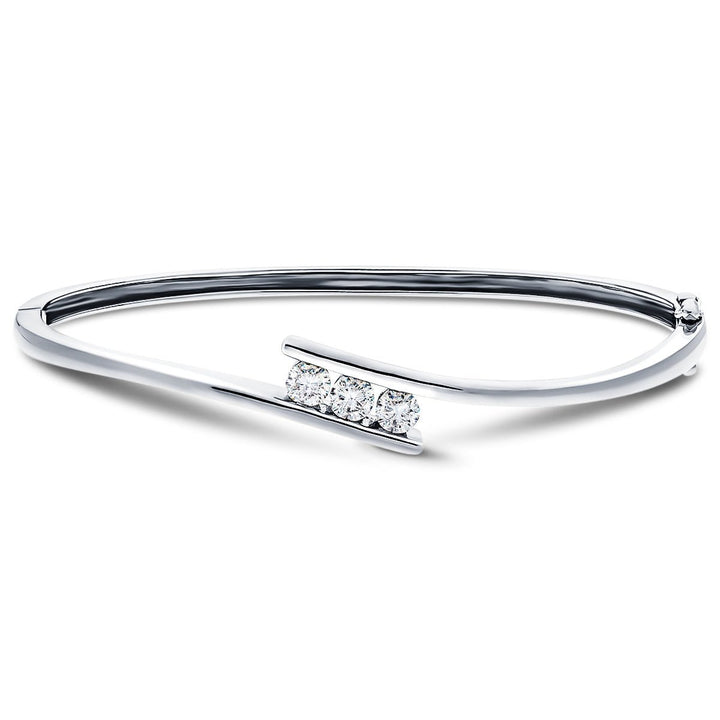
£2,430.00
£5,395.00
Unveil the epitome of modern elegance with the Lab Diamond Three Stone Bangle, exquisitely set in 18k white gold. This striking piece features 0.75ct of real diamonds, meticulously tension set to capture the light from every angle, illuminating its wearer's… read more
Consumer Perceptions
As you investigate the appeal of vintage alternatives, understanding consumer perceptions of lab-grown diamonds is key. Many consumers, about 70%, are aware of lab-grown diamonds, yet 47% still do not view them as "real." This perception impacts their emotional value, with lab-grown diamonds seen as less "authentic" and "romantic" compared to their natural counterparts.
Despite this, there is a growing acceptance as advancements in technology improve their quality, making them viable alternatives. Consumers appreciate the affordability, with lab-grown diamonds being 30-40% cheaper, appealing to those seeking more value for their budget. The affordability of lab-grown diamonds allows consumers to maximise their purchasing power, making them an attractive option for budget-conscious buyers. However, a significant concern is value retention, which affects consumer confidence in purchasing lab-grown diamonds.
| Aspect | Consumer Perception |
| Awareness | 70% know about lab-grown diamonds |
| Authenticity | 47% see them as not "real" |
| Emotional Value | Less romantic |
| Affordability | 30-40% cheaper |
| Market Share | 53% of the diamond market |
The surge in lab-grown diamonds, now holding 53% of the market, reflects shifting consumer attitudes. Many now see them as providing better value for money. Younger buyers, particularly, are drawn to these diamonds due to environmental concerns, despite some scepticism about their authenticity. This evolving perception highlights a balance between emotional value and practical considerations.
Ethical and Social Factors
 Which is Better? A Clean Lab or a Polluting Mine?
Which is Better? A Clean Lab or a Polluting Mine?Recognising the ethical and social factors behind lab-grown diamonds is crucial when considering their appeal.
These diamonds offer a path to ethical sourcing, sidestepping the controversies surrounding traditional diamond mining. You're likely aware of the negative social and environmental impact of natural diamond extraction. Lab-grown diamonds eliminate these concerns, embodying social responsibility without compromising on quality. They are produced with identical chemical and physical properties to natural diamonds, ensuring that you receive a product of equal excellence. Unlike mined diamonds, which require approximately 250 tonnes of earth to be displaced for just one carat, lab-grown alternatives present a more sustainable option.
With lab-grown diamonds, you can enjoy the freedom of choice with a clear conscience. Here are some compelling reasons why they're a socially responsible option:
- Ethical sourcing guarantees no conflict diamonds are involved, promoting peace.
- Social responsibility is prioritised, with fair labour practices.
- They support sustainable economies by reducing reliance on mining.
- Lab-grown diamonds eliminate health risks for workers associated with mining.
- By choosing them, you contribute to reducing ecological destruction.
Choosing lab-grown diamonds lets you partake in a movement towards sustainable luxury, combining beauty with ethics.
Unlike traditional diamond mining, which often devastates communities and environments, these diamonds offer a guilt-free alternative that respects both people and the planet.
Lab Diamond Cuban Link Bracelet 5.50ct in 9k Yellow Gold
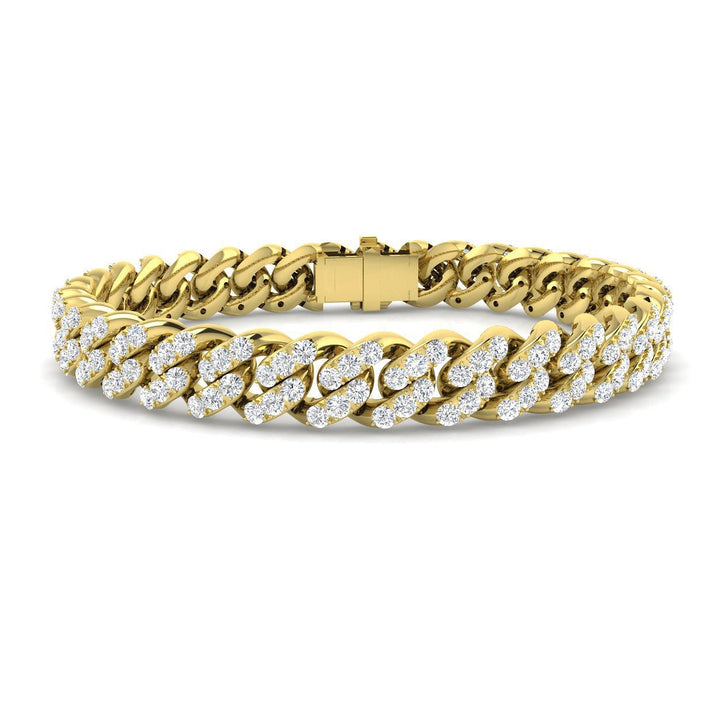
£2,700.00
£5,995.00
Discover unparalleled style with the Lab Diamond Cuban Link Bracelet, featuring a striking 5.50ct of D/VVS quality real diamonds, meticulously set in a pave setting for an exquisite display of brilliance. Crafted in luxurious 9k yellow gold, this bracelet boasts… read more
Explore Sustainable Luxury with After Diamonds
At After Diamonds, we believe that luxury and sustainability go hand in hand. Our stunning collection of lab-grown diamond jewellery combines timeless elegance with modern responsibility. Every piece is designed and handcrafted in the UK by skilled artisans, ensuring exceptional quality and attention to detail. To provide you with complete confidence, all our jewellery comes with a lifetime workmanship guarantee.
Lab-grown diamonds are not only a sustainable choice but also a reflection of ethical practices and environmental care. By choosing After Diamonds, you embrace a future where beauty doesn't compromise the planet.
Ready to find the perfect piece? Explore our full range of high-quality lab-grown diamond jewellery and experience the brilliance of sustainable luxury.
Browse the collection now at After Diamonds.
Mens Lab Diamond Signet Ring 0.10ct D/VVS in 925 Silver
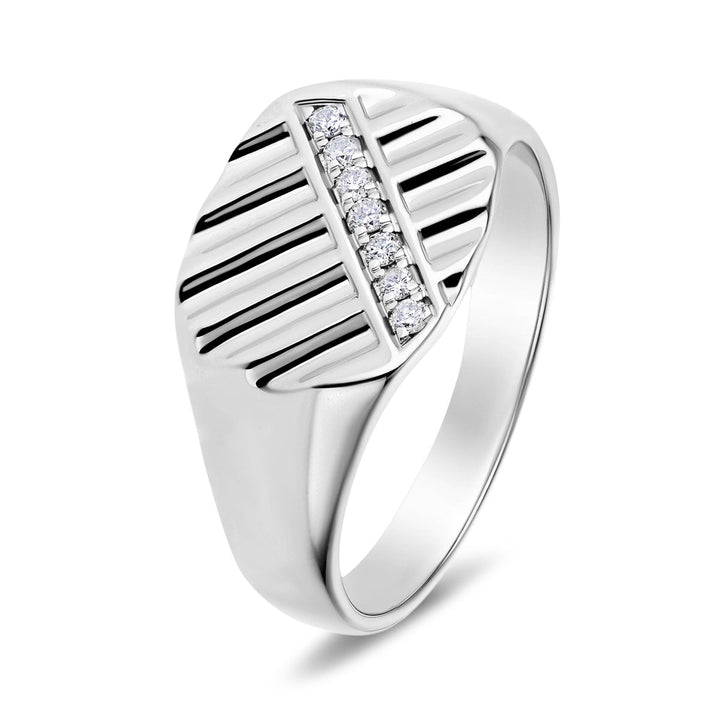
£155.00
£255.00
Unveil the essence of elegance and masculinity with the Men's Lab Diamond Signet Ring, a distinguished piece that effortlessly combines modern luxury with timeless appeal. This ring features a 0.10ct lab-created diamond, meticulously set in a claw setting to highlight… read more
Frequently Asked Questions
How Do Lab-Grown Diamonds Compare in Cost to Natural Diamonds?
When comparing the price of lab-grown to natural diamonds, you'll find lab-grown options considerably cheaper. Market trends show lab-grown prices dropping due to increased supply, offering you affordable luxury without compromising on quality.
Can Lab-Grown Diamonds Be Customised for Unique Jewellery Designs?
You can unleash your creativity with custom design options for lab-grown diamonds, offering unique jewellery personalisation. Embrace the freedom to tailor pieces to your style, crafting bespoke designs that truly reflect your individuality and taste.
What Technological Advancements Are Driving Lab-Grown Diamond Production?
You're witnessing a revolution in lab-grown diamond production. Technological advancements, such as carbon sourcing and ethical practices, drive efficiency and quality. Embrace the freedom of choice and customisation without compromising on sustainability or ethical standards.
Are There Aesthetic Differences Between Lab-Grown and Natural Diamonds?
You won't spot aesthetic differences between lab-grown and natural diamonds with the naked eye. Both boast similar brilliance, though lab-grown ones might show fewer inclusions. Colour variations are minimal, ensuring freedom in choosing your perfect gem.
How Long Does It Take to Produce a Lab-Grown Diamond?
You'll find the production timeline for lab-grown diamonds varies based on diamond growth methods. Expect a 1-carat diamond in 2-8 days, while larger gems take weeks. Your choice impacts the growth duration and quality.




